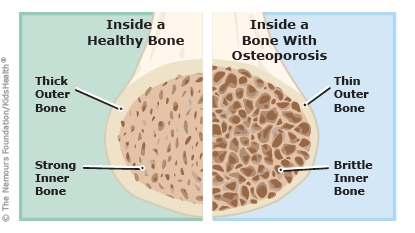People with osteoporosis (os-tee-oh-puh-ROH-sis) have weak bones that can break easily. Because kids' bones are still growing and developing, treatment usually can help them get strong again. Treatment may include medicines, supplements (like calcium and vitamin D), physical therapy and exercise, and meeting with a nutritionist.

Follow your health care provider's instructions for:
- giving any medicines or supplements
- taking your child for any blood tests or medical tests
- scheduling visits with any specialists, such as an orthopedic (bone) doctor, a nutritionist, or a physical therapist
- when to follow up
Calcium and vitamin D
- Calcium
- Good sources of calcium include milk (including milk substitutes like soy milk and almond milk), yogurt, cheese, soybeans (edamame), tofu, dark green leafy vegetables, and calcium-fortified breakfast cereals and juices.
- Check nutrition labels to make sure your child gets enough calcium every day:
- Kids 1–3 years old need 700 mg a day.
- Kids 4–8 years old need 1000 mg a day.
- Kids 9 years and older need 1300 mg a day.
- Give your child calcium supplements, if recommended by your health care provider.
- Vitamin D
- Vitamin D is often added to milk, yogurt, baby formula, juice, cereal, and other foods. Other sources include salmon, tuna, liver, eggs, and cod liver oil.
- Check nutrition labels to make sure your child gets enough vitamin D (try for 600–1,000 IU daily).
- Kids also get vitamin D from the sun. If your health care provider says it's OK, your child can be in the sun for 10–15 minutes a day without sunscreen. For longer periods, be sure to protect your child's skin with sunscreen, clothing, and shade. There is a risk for skin cancer later in life if your child gets too much sun.
- Give your child vitamin D supplements, if recommended by your health care provider.
Physical activity
Help your child get at least 1 hour of physical activity each day. Activities that help build strong bones best are:
- weight-bearing activities: walking, running, climbing stairs, and jumping
- sports: soccer, basketball, tennis, volleyball, field hockey, and track
- weightlifting and strength training
Low-impact activities like swimming or biking are good exercise and great for overall health, but less helpful for bone health.
Kids who have problems with movement can work with a physical therapist to find activities to help them build strong bones.
No smoking
Along with many other health risks, smoking weakens bones. Your child should not smoke, and no one should smoke around them. If you or someone in your household needs help quitting, call 800-QUIT-NOW or visit smokefree.gov.

You think your child has a broken bone.

How does osteoporosis happen? Our bodies use calcium to build bones and keep the muscles and nervous system working properly. When kids don't get enough calcium from food or supplements, calcium is taken from the bones to be used by other parts of the body. Over time, this weakens the bones.
Why do some kids get osteoporosis? Although osteoporosis is more common in older adults, it can happen in kids. In kids, it's usually from:
- a chronic (long-lasting) illness
- a hormonal imbalance
- an eating disorder
- lack of movement (for example, if they use a wheelchair)




